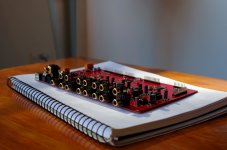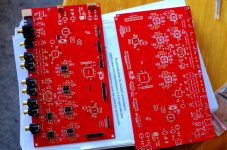Good day all,
Some time ago I had started a thread about making a project with existing boards I had from a previous project. Well, after investigating several directions the project could follow, based on feedback from this forum and from other mates, I realized I needed to design a new board specifically tailored for the task.
This time the project is really on track and I'm happy to start this new thread with a picture of the recently born little baby. More info will follow shortly.
Cheers
chaparK

Some time ago I had started a thread about making a project with existing boards I had from a previous project. Well, after investigating several directions the project could follow, based on feedback from this forum and from other mates, I realized I needed to design a new board specifically tailored for the task.
This time the project is really on track and I'm happy to start this new thread with a picture of the recently born little baby. More info will follow shortly.
Cheers
chaparK

Yes indeed, the previous board had a DSP56321. This one has a dual-core DSP56725 😉
any reason for sticking with a 24 bit DSP when 32 bit DSP's are typical these days ?
The number of bits is not really relevant. It's all about properly scaling the signal through the processing flow and you can anytime switch to double precision mode in case of need.
24-bit is plenty for audio signals: you wouldn't be able to *measure* the difference between properly processed 24-bit and 32-bit audio - left alone hearing any difference.
24-bit is plenty for audio signals: you wouldn't be able to *measure* the difference between properly processed 24-bit and 32-bit audio - left alone hearing any difference.
The number of bits is not really relevant. It's all about properly scaling the signal through the processing flow and you can anytime switch to double precision mode in case of need.
24-bit is plenty for audio signals: you wouldn't be able to *measure* the difference between properly processed 24-bit and 32-bit audio - left alone hearing any difference.
what is the sample rate and number of channels ?
This time the project is really on track and I'm happy to start this new thread with a picture of the recently born little baby. More info will follow shortly.
View attachment 289590
Look's good,
Could share some insight details, number of channels, sampling rate, ADC - DAC type and so on please ?
Best from France
JC
Thanks guys for your interest.
I can't go too much into the details right now, but I can say that 48kHz, 96 kHz and 192 kHz are all 3 natively supported by the DSP and that sampling frequency is user selectable while configuring the board.
I can't go too much into the details right now, but I can say that 48kHz, 96 kHz and 192 kHz are all 3 natively supported by the DSP and that sampling frequency is user selectable while configuring the board.
I can't go too much into the details right now, but I can say that 48kHz, 96 kHz and 192 kHz are all 3 natively supported by the DSP and that sampling frequency is user selectable while configuring the board.
Well, so I think that I just have to wait then 🙁 until you reveal some more details
So I can reveal now that the board has following IOs:
- Stereo analogue input
- Stereo digital input
- 8 analogue outputs with analogue volume control
- 10 digital outputs (8 of them carry the signal of the analogue outs before DA conversion)
- 2 I2S expansion ports
The board also features headers for keypad with 8 push-buttons, LCD, status leds and IR sensor as well as a USB connector for the control application. Peripheral management is performed by a micro-controller so that the DSP stays fully available for DSP routines.
- Stereo analogue input
- Stereo digital input
- 8 analogue outputs with analogue volume control
- 10 digital outputs (8 of them carry the signal of the analogue outs before DA conversion)
- 2 I2S expansion ports
The board also features headers for keypad with 8 push-buttons, LCD, status leds and IR sensor as well as a USB connector for the control application. Peripheral management is performed by a micro-controller so that the DSP stays fully available for DSP routines.
How much is it ?
How do you program it ? PC or User Interface ?
do you have a website ?
How do you program it ? PC or User Interface ?
do you have a website ?
Last edited:
How much is it ?
How do you program it ? PC or User Interface ?
do you have a website ?
I don't have pricing information yet, but it's going to be cheap.
Programming takes place via remote computer with a cross-platform control application. User interface is for source selection, preset, volume ... and some goodies 🙂
Yes I have a website but there's no information relative to this board at that time. I need some more time until I can release the product.
Below is a pic of the PCBs before assembly. At that time I was just making sure that the connectors were fitting properly.
Note that all OPs are on sockets so one can use his favorite model. Also, the caps on the signal path are Through-Hole so easy to replace.

indeed a great job....
a couple of question
in case of a digital only use, is it possible not to populate analog circuit?
i2S is available as input too?
a couple of question
in case of a digital only use, is it possible not to populate analog circuit?
i2S is available as input too?
Last edited:
possibilities for tapping balanced output filters?
if not I second this
i'm interested too, but mainly digital out as I have the dac side fully sorted with a 2 balanced sabre dacs
if not I second this
looks like a 4 layer board trevor, application notes for DSP chips would be unlikely to cover 2 layer designs, I can see plenty of vias which hints at multilayerin case of a digital only use, is it possible not to populate analog circuit?
i'm interested too, but mainly digital out as I have the dac side fully sorted with a 2 balanced sabre dacs
Thanks all for your comments!
I intend to make available a 'light' version beside of the full one.
The light version would have no analogue volume control, and volume would be handled digitally in that case. Note however that the user of such a board would be able anytime to add himself the chip and get analogue volume, but this will require fine pitch smd soldering.
This would allow users on a budget to make some savings because the bare analogue volume chip is rather expensive.
Regarding I2S, yes it's available as both input and output.
Yes CS3318.
indeed a great job....
a couple of question
in case of a digital only use, is it possible not to populate analog circuit?
i2S is available as input too?
I intend to make available a 'light' version beside of the full one.
The light version would have no analogue volume control, and volume would be handled digitally in that case. Note however that the user of such a board would be able anytime to add himself the chip and get analogue volume, but this will require fine pitch smd soldering.
This would allow users on a budget to make some savings because the bare analogue volume chip is rather expensive.
Regarding I2S, yes it's available as both input and output.
Looks very nice. The analog volumecontrol, what kind of chip do you use? Cs3318?
Yes CS3318.
Last edited:
I intend to make available a 'light' version beside of the full one.
The light version would have no analogue volume control, and volume would be handled digitally in that case. Note however that the user of such a board would be able anytime to add himself the chip and get analogue volume, but this will require fine pitch smd soldering.
This would allow users on a budget to make some savings because the bare analogue volume chip is rather expensive.
Regarding I2S, yes it's available as both input and output.
Well consider me thoroughly interested!
- Home
- Source & Line
- Digital Line Level
- DSP Xover project (part 2)